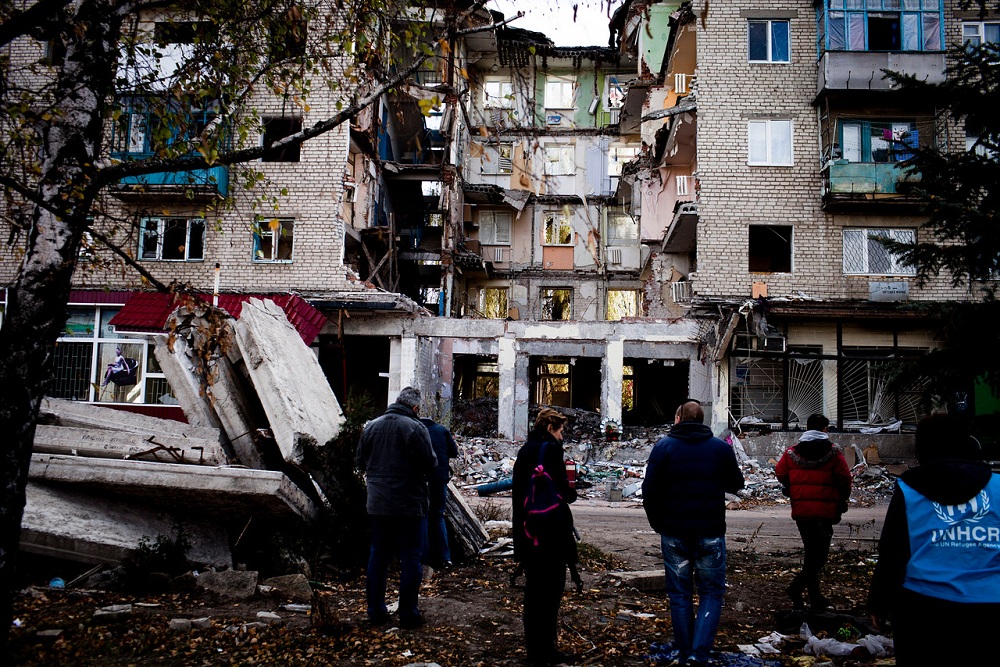
Credit: UNHCR
The report was originally published at ReliefWeb.
NEEDS & KEY FIGURES
While absent from the international radar, the conflict in eastern Ukraine and its resulting humanitarian needs are a daily reality for 4.4 million people affected by the conflict, with no hopes for a quick end to their suffering.
Some 3.8 million need humanitarian assistance, including livelihood and early recovery. Despite commitments to ceasefire over the past 30 months, hostilities continue. Of more than 10,000 people killed, 2,000 are civilians.
Houses, schools, hospitals and other critical infrastructure continue to suffer damage. Some IDPs decided or were forced to return, as they could not afford anymore to live in the Government-controlled areas (GCA) where livelihood and shelter solutions are insufficient. However, they still continue to face difficulties in accessing Government support as well as limited services and markets in areas beyond Government control (NGCA).
The conflict also intensified pre-existing systemic flaws, from ageing infrastructures to legislative shortcomings, etc. that, in turn, adds to the complexity of the situation, requiring concurrent humanitarian, recovery and development action. Insecurity, access constraints and limited resources are major challenges. In winter, when temperatures drop below -20 degrees Celsius, any gap in assistance delivery will have life-threatening consequences.
1. Protection
Civilians continue to bear the brunt of the conflict.
Hostilities, presence of landmines and Explosive Remnants of War (ERW) continue to threaten their lives and livelihoods. The Government’s decision to suspend social payments for 500,000-600,000 IDPs has had a devastating impact, particularly on IDP pensioners, many of whom live in NGCA. Legislation links the IDP status to access to social benefits, pensions and aid. The protractedness of displacement, Gender Based Violence (GBV), concerns related to housing, land and property are just some of the other major protection concerns. In 2016, many people returned back to NGCA as they could not afford living in GCA, in some cases, to areas of active hostilities. Others moved to places where humanitarian assistance is available. This unintended consequence of aid deliveries could become a significant pull factor unless people’s access to assistance, basic services and livelihood is addressed.
2. Access
Access for people to goods, services and aid is challenging.
The operating environment in Donetska and Luhanska oblasts continues to be volatile, affecting assistance delivery.
The ‘contact line’ has evolved into a difficult-to-cross border. Continued insecurity further hampers access for civilians and humanitarian actors alike. The temporary closure of the few main access corridors to NGCA regularly increases the hardship for people crossing. In NGCA, the de facto authorities imposed a mandatory ‘registration’ process of aid organisations, resulting in the suspension of operations for many actors. Some assistance continues to be provided, directly or indirectly, including through remote management. Government imposed bureaucratic impediments still remain in place.
3. Emergency shelter, water, health
Time-critical humanitarian needs include shelter, water and health for people living along the ‘contact line’, in NGCA and in pockets of GCA. Access to health for one third of households in the conflict area is hampered, in an environment where every second family reports having one or more family members suffering from a chronic illness. Housing repairs continue, but ongoing shelling triggers new needs every day. Concerns on shelter, access to heating and running water are particularly high in winter. The risk and incidences of water shortages remain high across the frontline as worn-out water supply infrastructure continues to suffer damage.
Lack of mechanisms to pay utility bills across the ‘contact line’ also resulted in interruption of critical life-saving services, including water
4. Disrupted livelihoods, finding durable solutions
As the situation becomes protracted, many civilians are increasingly unable to fend for themselves. Loss of livelihoods affects their ability to access basic services and erodes their ability to cope, especially for those living along the ‘contact line’ and in NGCA. This is further compounded by the difficult economic situation of the country, which results in increased vulnerabilities for many conflict-affected people. Depletion of savings is pushing many into debt forcing them into negative coping mechanisms. While some of the most urgent needs are addressed through the delivery of humanitarian aid, many households continue to struggle to survive and pay for basic services. The most vulnerable, both displaced and host communities alike, require solutions which go beyond humanitarian aid focusing on recovery and enabling self-sufficiency, including in NGCA.
The full report could be downloaded in English and in Ukrainian.
UN Office for the Coordination of Humanitarian Affairs:
To learn more about OCHA’s activities, please visit http://unocha.org/.


